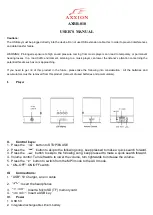
6
REV C
OPM-118
UNIT CAPABILITIES
GENERATOR CONNECTIONS
DP5000/T: 120 Volt and 240 Volt receptacles are provided for
connection to various loads. The diagram below represents this 4,500
watt (rated output) generator. A & B represent the 120 volt output legs
of this generator. Up to 2,250 watts at 120 volts (37.5 Amps) can be
drawn from the receptacles attached to either A or B output legs. This
generator is capable of producing 18.75 Amps of 240 volt current at C.
Check the appliance or tool nameplates for the current and voltage to
insure compatibility. Remember that power taken from C reduces the
power available at equally both A and B and vice versa.
STARTING ELECTRIC MOTORS
Electric motors require much more current (amps) to start them than to
run them. Some motors, particularly low cost split-phase motors, are
very hard to start and require 5 to 7 times as much starting current as
running current. Capacitor motors are easier to start and usually require
2 to 4 times as much starting current as running current. Repulsion
Induction motors are the easiest to start and require only 1 1/2 to 2 1/2
times as much starting as running current.
Most fractional horsepower motors take about the same amount
of current to run them whether they are Repulsion Induction (RI),
Capacitor (Cap), or Split-Phase (SP) type.
If the electric motor is connected to a hard starting load such as an air
compressor, it will require more starting current. If it is connected to a
light load, or no load such as a power saw, it will require less starting
current. The exact requirement will also vary with the brand or design
of the motor.
Self-exciting generators respond to severe overloading differently than
utility power. When overloaded, the engine is not able to supply enough
power to bring the electric motor up to operating speed. The generator
responds with high initial starting current, but the engine speed drops
sharply. The overload may stall the engine. If allowed to operate at very
low speeds, the electric motor starting winding will burn out in a short
time. The generator winding might also be damaged.
CAUTION: EQUIPMENT DAMAGE
Running the generator set under these conditions may result in
damage to the generator stator as well as the motor winding.
The heavy surge of current required for starting motors is required for
only an instant. The generator will not be damaged if it can bring the
motor up to speed in a few seconds of time. If difficulty is experienced
in starting motors, turn all other electrical loads off and if possible
reduce the load on the electric motor.
PREPARING THE UNIT
UNPACKING
CAUTION: EQUIPMENT DAMAGE
THIS UNIT HAS BEEN SHIPPED WITH OIL. Failure to maintain the
engine oil at the proper level will result in serious engine damage.
When you unpack your engine-generator set be sure to remove all the
information sheets and manuals from the carton.
1. As you receive your unit, it is critical to check it for any damage. If
any damage is noted, it is always easiest to refuse the shipment and
let WINCO take care of the freight claim. If you sign for the unit, the
transfer of the ownership requires that you file the freight claim
2. Before proceeding with the preparations of your new generator
for operation, take a couple of minutes to ensure the unit you have
received is the correct model and review the specification pages in this
manual to ensure that this unit meets your job requirements.
LUBRICATION
Before starting the engine, check that the crankcase has the proper
level of a good quality oil. The recommended grade oil and quantity
of oil required is listed in the engine operator’s manual and in the Oil
Recommendations section of this manual. The engine normally holds
38.4 ounces (1.2 quarts) of oil. Use the dipstick to ensure that you
have the correct amount of oil. The full oil level mark on the dipstick is
depicted in the following image.
If needed, oil is added to the engine by removing the oil cap and adding
oil at this point. After filling the crankcase to the proper level, be sure
you properly tighten the oil fill cap.
NOTE: This engine generator must be on a level surface before you
check or add oil to the system.
The necessity of using the correct oil and keeping the crankcase full
cannot be overemphasized. Engine failures resulting from inadequate
or improper lubricant are considered abuse and not covered by the
generator or engine manufacturer’s warranty.


































